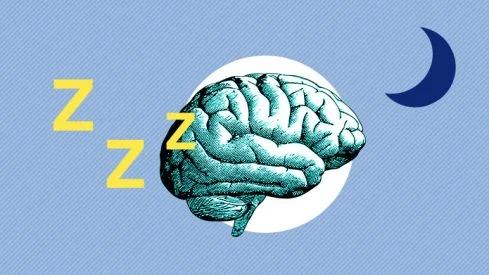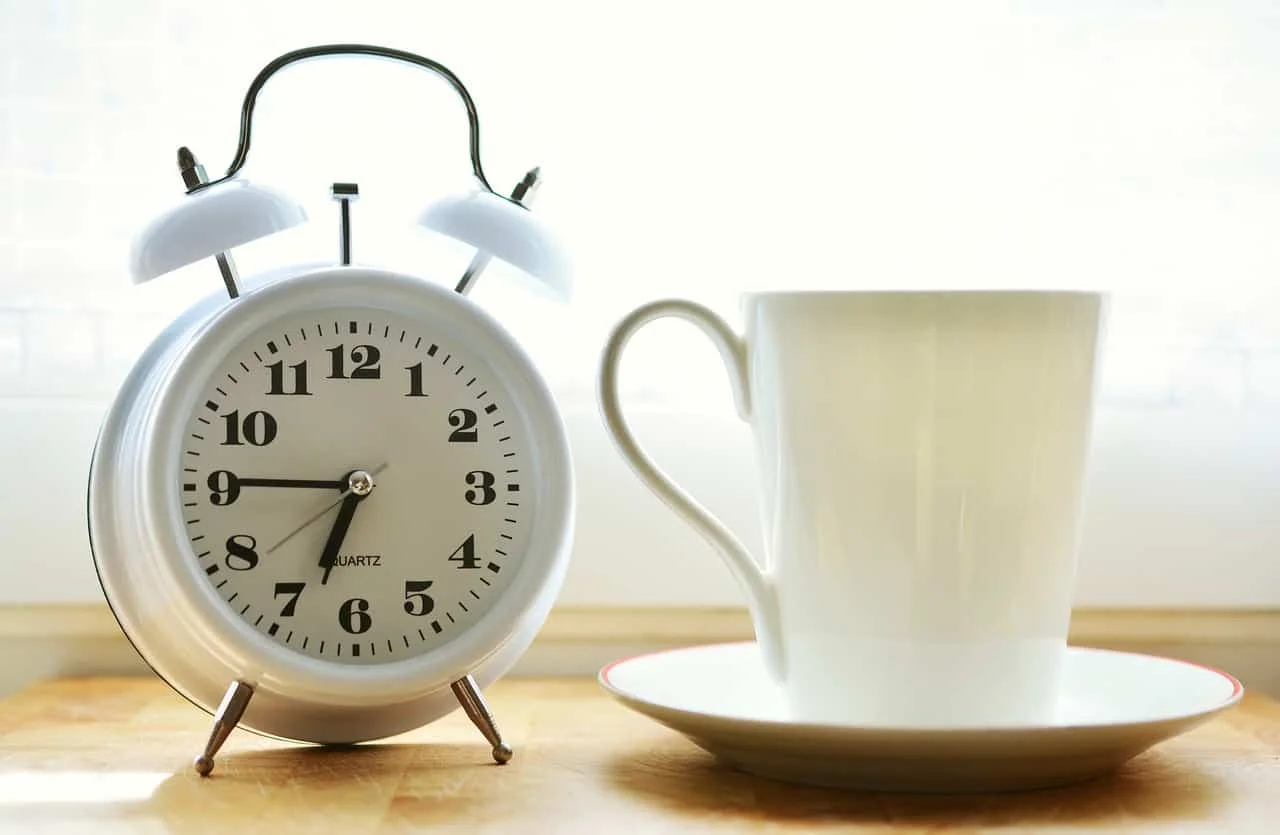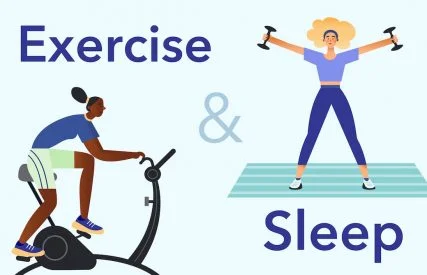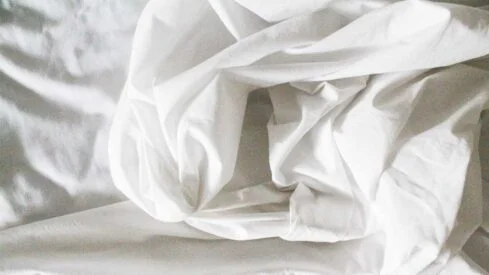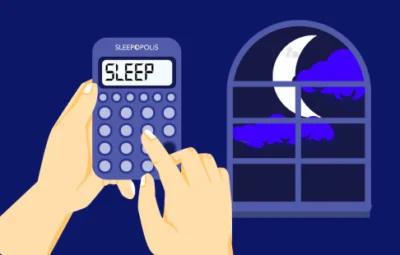
Neither late nor early, the sleep and wake schedule of the bear chronotype typically follows the sun. These guys rise when the sun peeks over the horizon, and they usually start thinking about sleeping somewhere around twilight. Those who fall under the bear chronotype are usually most productive in the morning and early evening but battle the afternoon slump on a daily basis. Like any chronotype, bears can maximize their productivity and enjoy better sleep when they fully understand their chronotype and their bear personality. Not sure what Chronotype you are? Take our quick chronotype quiz to find out!
Long Story Short
- Chronotype influences the timing of when your body naturally desires sleep, not how much sleep you need.
- The bear chronotype sleep schedule aligns with sunrise and sunset.
- Peak productivity time for bears is often midmorning to early evening.
What Is a Chronotype?
The term chronotype refers to an individual’s natural inclination for sleep and wake patterns based on their internal biological clock, also known as circadian rhythm. Everyone has a chronotype determined by various hormones, blood pressure levels, body temperature, and mood. Humans are unique compared to other animals in that they differ more individually with sleep schedules. Most people are bear chronotypes, also known as “larks” in some research.
Chronotypes are often influenced by a combination of genetic, environmental, and behavioral factors. When bears understand their chronotype, they can better optimize productivity and performance by aligning daily activities (including sleep and work schedules) to meet their biological needs.
The Bear Chronotype
The bear chronotype, which was introduced by Dr. Michael J. Breus, PhD, in 2016, is neither an early bird (lion) nor a night owl (wolf). “The bear chronotype represents individuals who follow a solar-based sleep-wake pattern, rising with the sun and feeling sleepy as the sun sets,” says Dr. Carly Claney, a licensed psychologist and founder and CEO of Relational Psych. “Bear chronotypes comprise about 50-55 percent of the population. They have higher levels of productivity (or access to “deep work”) in the morning and lower levels of focus in the afternoon.”
A bear personality is mindful, conscientious, and easy to get along with socially. They’re often open to new experiences and live more as an extrovert. Bears may avoid conflict and hold positive social relationships. This chronotype may prefer stability and oppose change in their routines.
The Best Bear Chronotype Sleep Schedule
Bear sleep habits typically match celestial events and timing. These guys wake with the sun and usually begin feeling sleepy around sunset. The most productive time for bear chronotypes is late morning to early afternoon, and the afternoon slump is real.
Based on their natural circadian rhythms, a typical bear chronotype schedule looks something like this.
Wake Up: 7 a.m. – 8 a.m.
While it’s easy to confuse bears with lions, the two differ in temperament and timing. Unlike lion chronotypes, bears typically rise with the sun, not before — usually somewhere around 7 a.m. – 8 a.m.
Focused and Working Hard: 10 a.m. – 2 p.m.
Bear chronotypes are usually most productive from midmorning to early afternoon. In the hours between 10 a.m. and 2 p.m., bears are likely to be found with their nose to the grindstone giving it 110 percent.
Energy Wanes: 3 p.m. – 6 p.m.
After four hours of intense productivity, bears will likely experience a dip in their energy. Late afternoon and the hours before quitting time should be reserved for lighter tasks.
Extended Bedtime Routine: 6 p.m. – 9 p.m.
Bedtime routines aren’t just for babies, and bear chronotypes know this. Bears like them, and they like them long. From 6:00 to 9:00 p.m., you can probably find your favorite bear leaning into a solid wind-down routine.
Bedtime: 11 p.m.
Bear chronotypes don’t shortchange their sleep — a full 8 hours is mandatory. So while these guys start to feel sleepy as early as sunset, “lights out” is typically around 11 p.m. for a 7 a.m. wake-up.
Tips for Getting Through the Day as a Bear
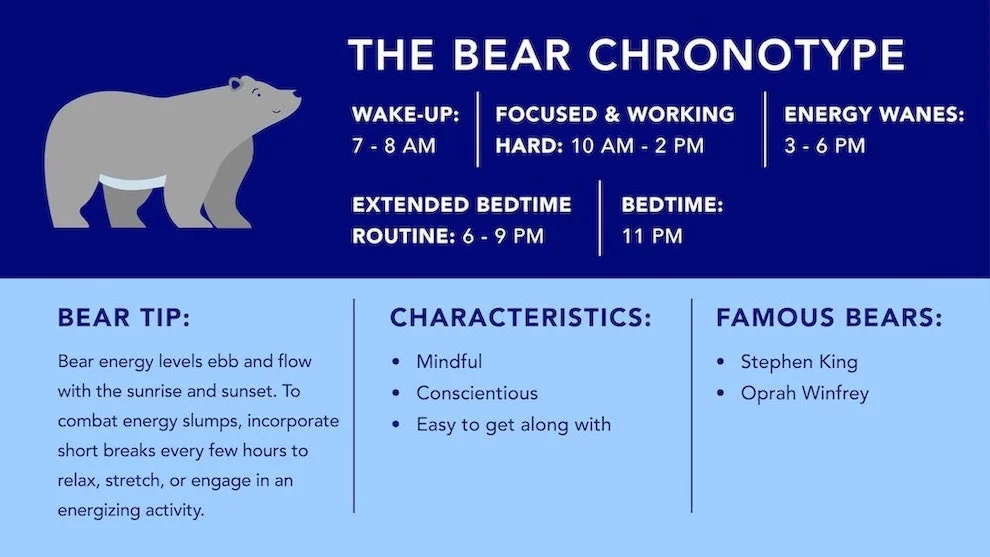
Because their internal clock follows the sun, bears would do best to schedule challenging tasks and projects for the morning and lighter checklist items that don’t require a lot of focus for the afternoon. Ahead, we offer bear chronotypes some pointers for optimizing their daily calendars, scheduling their meals, and finding the right time for exercise.
Capitalize on the Morning
Bears tend to be most productive and alert in the morning and early afternoon. So, make that to-do list in the morning and tackle the most important things first. This schedule will ensure you’re most productive without causing too much stress.
Manage the Afternoon Slump
The afternoon slump is time for your light activities and tasks. It’s a good time to take a break, go for a walk, or engage in a quick physical activity to get your blood flowing and an energy boost. Staying hydrated with water can also help improve your energy levels.
Maintain a Consistent Sleep Schedule
Maintaining good sleep hygiene that includes a regular sleep schedule is helpful for bears. A regular sleep pattern ensures you go through the stages of sleep successfully and wake up rested and healthy.
Create a Conducive Workspace
To make the most of peak (and not so peak) productivity windows, consider making your workspace one that promotes focus and productivity. It should have great lighting, stay organized, and with all materials readily available to keep you efficiently working.
Prioritize Breaks
To maintain energy levels and prevent quick burnout during the day, bear chronotypes can take fast breaks every few hours to promote relaxation and calm. A quick walk or stretch can also give you an energy boost.
Meal Timing for Bear Chronotypes
Breakfast
Since bears tend to wake up relatively early, a balanced breakfast shortly after waking up is a good idea. A nutritious breakfast can help keep you alert and boost your performance.
Lunch
Bears might plan lunch around midday; somewhere between 12 p.m. and 1 p.m. is ideal. A midday fuel-up will ensure you maintain a steady energy flow throughout the afternoon.
Afternoon Snack
To get through the afternoon slump, bear chronotypes can incorporate a light snack between lunch and dinner. A healthy bite around 3 p.m. will help sustain your energy levels and keep hunger pains at bay.
Dinner
Six o’clock is a typical dinner hour for bears. At that point, their bodies start to wind down and relax. A good healthy meal is a great step in your sleep schedule to ensure you avoid belly upset that might keep you up at night.
Exercise
If you’re a bear, you might benefit most by exercising in the morning or early afternoon. That’s when you’re likely at your best for physical activity. Also, working out right around your afternoon slip may help give you the energy boost your body needs to face the rest of the day.
You know your schedule and what works for you. Some bears may do great working out in the early evening, while others have a slump at a different part of the day. The key is to keep your routine consistent, whatever it may be, and know you can make adjustments based on your chronotype to help with daytime sleepiness and overall health.
FAQs
When should a bear chronotype eat?
Bear chronotypes should eat breakfast shortly after waking up, incorporate a late afternoon snack to combat waning energy levels, and plan for dinner somewhere between 6 p.m. to 8 p.m.
When should I exercise as a bear chronotype?
Bear chronotypes should plan on exercising in the morning or early afternoon.
The Last Word From Sleepopolis
Bear chronotypes aren’t early birds or night owls. These guys fall somewhere in between. Their sleep and wake schedules may follow the sun, but their energy waxes and wanes like any other chronotype. While bears are usually hard at work from late morning to early afternoon, their energy continuously wanes until it’s time to sack out around 11 p.m.
Sources
Kalmbach DA, Schneider LD, Cheung J, et al. Genetic Basis of Chronotype in Humans: Insights From Three Landmark GWAS. Sleep. 2017;40(2):zsw048. doi:10.1093/sleep/zsw048
Haldar, P.; Debnath, S.; Adan, A.; Jankowski, K.S.; Chattopadhyay, D.; Maity, S.G.; Moitra, S.; Lacy, P.; Moitra, S. Role of Living Conditions and Socioenvironmental Factors on Chronotype in Adolescents. Adolescents 2021, 1, 95–107. https:// doi.org/10.3390/adolescents1020008
Heyde, I., Oster, H. Differentiating external zeitgeber impact on peripheral circadian clock resetting. Sci Rep 9, 20114 (2019). https://doi.org/10.1038/s41598-019-56323-z
Randler, C., Schredl, M., & Göritz, A. S. (2017). Chronotype, Sleep Behavior, and the Big Five Personality Factors. SAGE Open, 7(3). https://doi.org/10.1177/2158244017728321
Sussex Publishers. (n.d.-a). The four chronotypes: Which One are you?. Psychology Today. https://www.psychologytoday.com/us/blog/sleep-newzzz/202104/the-four-chronotypes-which-one-are-you
Breus , M. (2021, April 1). There is more to your chronotype than being a night owl or morning bird. LinkedIn. https://www.linkedin.com/pulse/more-your-chronotype-being-night-owl-morning-bird-michael-breus
Gibney, M. J., Barr, S. I., Bellisle, F., Drewnowski, A., Fagt, S., Livingstone, B., Masset, G., Varela Moreiras, G., Moreno, L. A., Smith, J., Vieux, F., Thielecke, F., & Hopkins, S. (2018). Breakfast in Human Nutrition: The International Breakfast Research Initiative. Nutrients, 10(5), 559. https://doi.org/10.3390/nu10050559
Lunsford-Avery, J.R., Engelhard, M.M., Navar, A.M. et al. Validation of the Sleep Regularity Index in Older Adults and Associations with Cardiometabolic Risk. Sci Rep 8, 14158 (2018). https://doi.org/10.1038/s41598-018-32402-5
Dr. Carly Claney. Email Communication. June 14, 2024.
